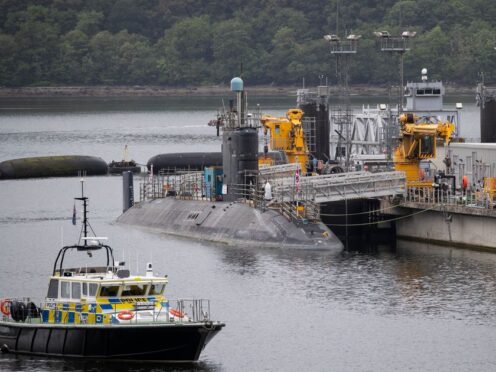
Removing nuclear weapons from Scotland in the “most expeditious manner possible” after leaving the UK should not prevent it from joining Nato, the Scottish Government’s latest paper on independence said.
The paper sets out that Scotland would seek to join Nato, as well as the United Nations and the European Union as soon as possible after a vote for independence.
It goes on to pledge that, in an independent Scotland, the Scottish Government would “make it a cornerstone of defence policy” only to take part in military action overseas that is lawful and has been backed by both ministers and Holyrood.
The paper, which looks at defence in an independent Scotland, adds that “nuclear weapons should be removed from Scotland in the safest and most expeditious manner possible following independence”.
Our #ANewScotland paper sets out how an independent Scotland could be a good global citizen:
🔵 promoting and protects human rights 🔵 acting based on values and principles 🔵 building partnerships to address global challenges
ℹ️ https://t.co/W7tHsJt9yP pic.twitter.com/n81yMEKcLB
— Scottish Government (@scotgov) March 4, 2024
But the briefing paper, titled An Independent Scotland’s Place in the World, states: “Neither of these proposals would prevent Scotland’s ability to act in self-defence or join Nato.”
It commits to Scotland spending 2% of GDP on defence, in line with Nato requirements.
But it also promises an independent Scotland would commit to meeting the UN target of spending 0.7% of gross national income on international aid – something the UK currently fails to do.
The UK Government met the target for spending on official development assistance (ODA) from 2013 to 2020 – when the downturn sparked by Covid saw spending reduced to 0.5%, with Westminster having pledged to return to the higher level when the fiscal situation allows for it.

However, an independent Scotland would seek to enshrine the 0.7% commitment in law, with the paper stating: “This would give Scotland a sizeable aid budget with which to make an impact in the world’s poorest countries.”
On defence, the paper said that an independent Scotland would have its own armed forces, with decisions on their capability to be informed by a “comprehensive, expert-led defence and security review”.
It set how Scotland would “participate fully in the EU’s common security and defence policy”, by taking part in “missions that support global peace and security”.
Meanwhile, Scotland would “build on” its “strong relationships” with the rest of the UK and Ireland to help “ensure our mutual safety”, the paper said.

And a dedicated diplomatic network would be created to promote and protect Scottish interests overseas as well as providing consular support for Scottish citizens.
Commenting as the paper, the latest in the Government’s Building a New Scotland series, was published, External Affairs Secretary Angus Robertson said: “Scotland is already making a contribution on the world stage – where we can – to address global poverty, the climate and biodiversity crises and threats to human rights.
“But because we are not independent, Scotland has been forced into Brexit and contributing towards billions of pounds being spent on nuclear weapons.
“If Scotland had full participation in multilateral bodies, such as the UN, we could ensure our voice is heard on critical global issues, such as on the Israel-Gaza conflict.”
Mr Robertson added that having “full representation” within organisations such as the UN and the EU would allow the country to “negotiate directly to become party to international treaties, conventions and agreements that reflect Scotland’s values and ambitions as a good global citizen”.
He continued: “Our proposals also make clear that the armed forces of an independent Scotland, supported by a modern contract for personnel and strong support for veterans, would play their part to defend our national interests and contribute to global peace and security, given our strategic position in the North Atlantic.
“Ultimately, independence would enable Scotland to determine the kind of state it wants to be on the world stage.
“We firmly believe that the challenges of the 21st century are best faced through more, not less, co-operation and I look forward to engaging with as many people as possible on the opportunities highlighted in this paper as we look to Scotland’s future.”

Enjoy the convenience of having The Sunday Post delivered as a digital ePaper straight to your smartphone, tablet or computer.
Subscribe for only £5.49 a month and enjoy all the benefits of the printed paper as a digital replica.
Subscribe